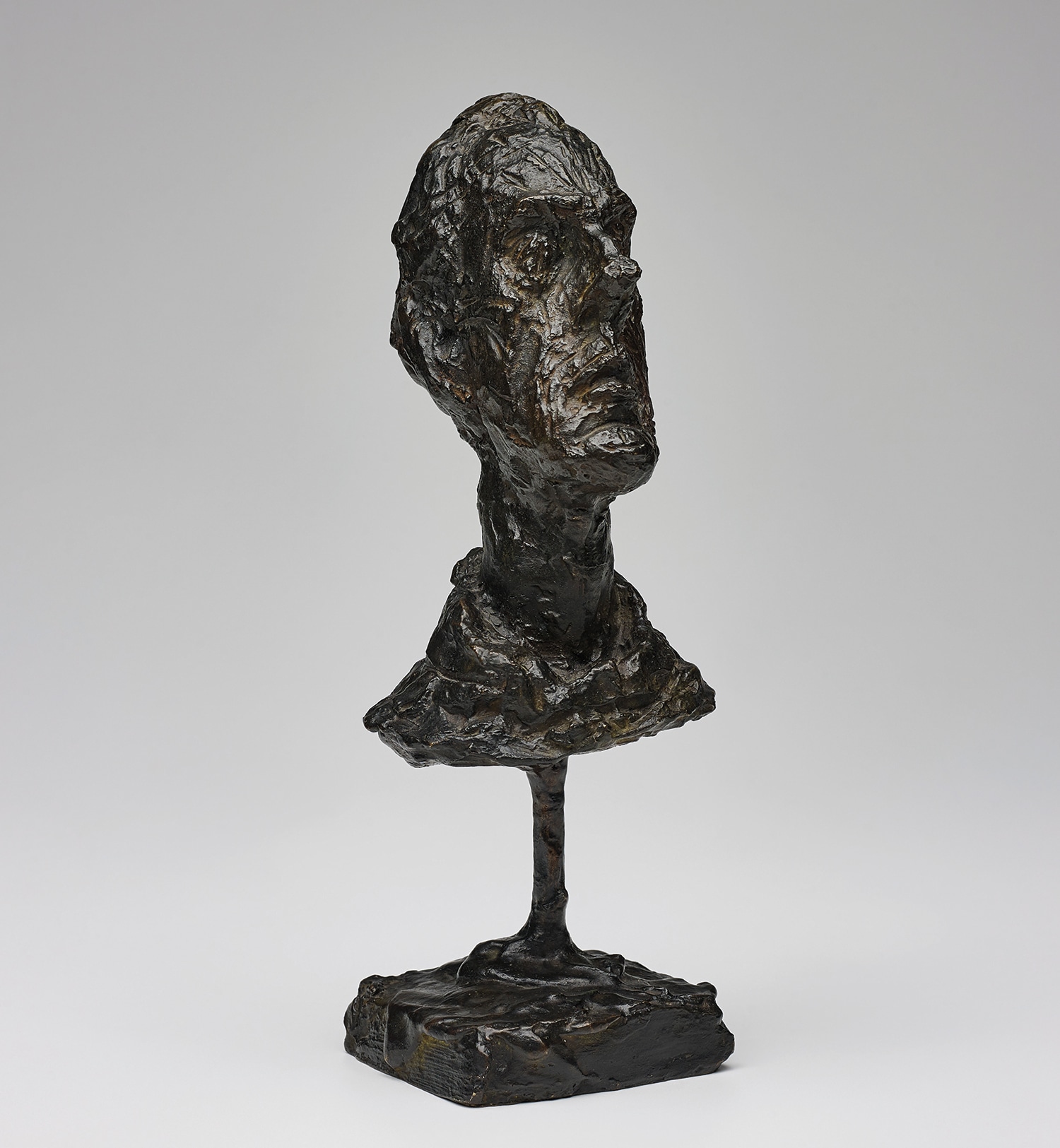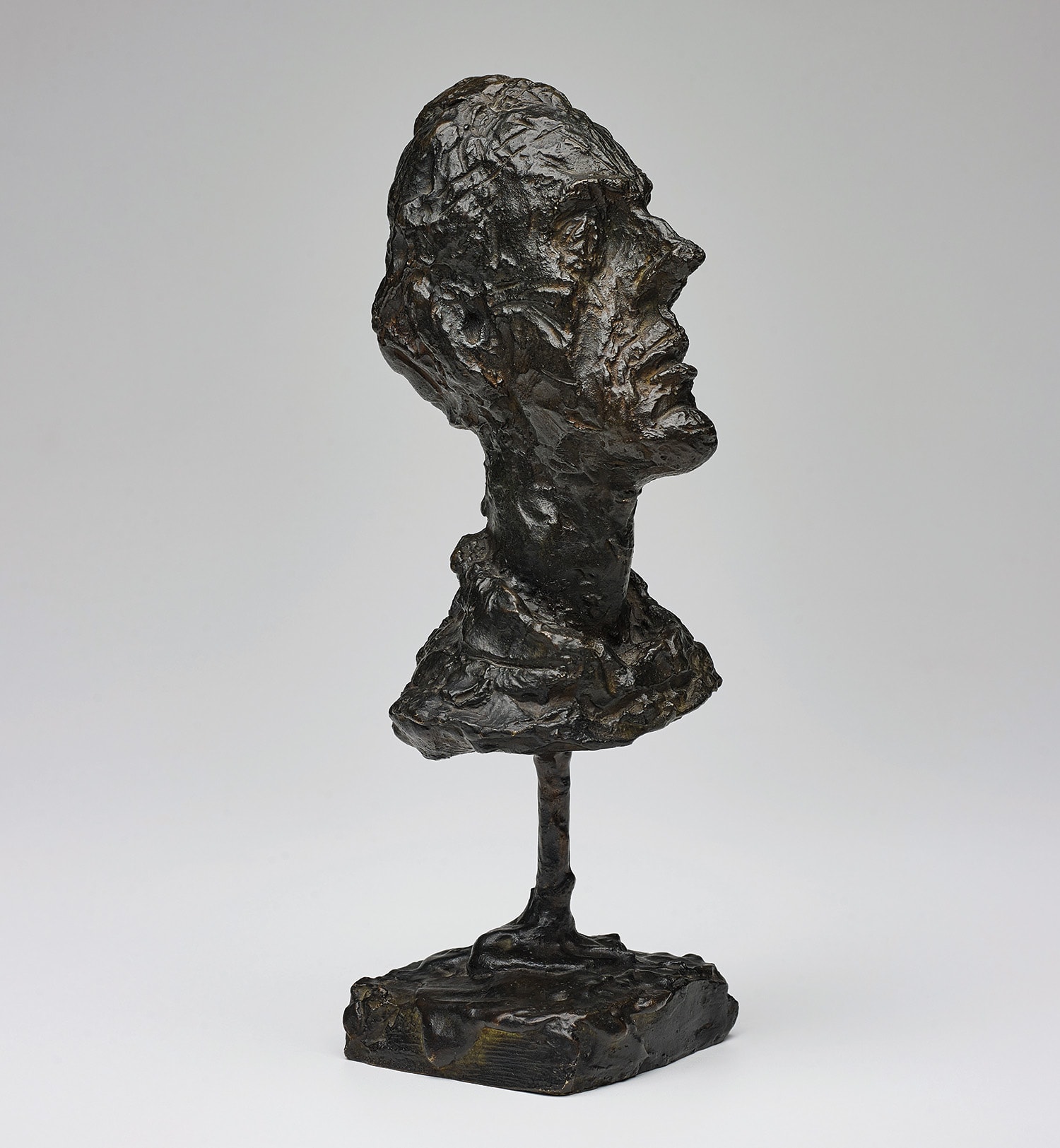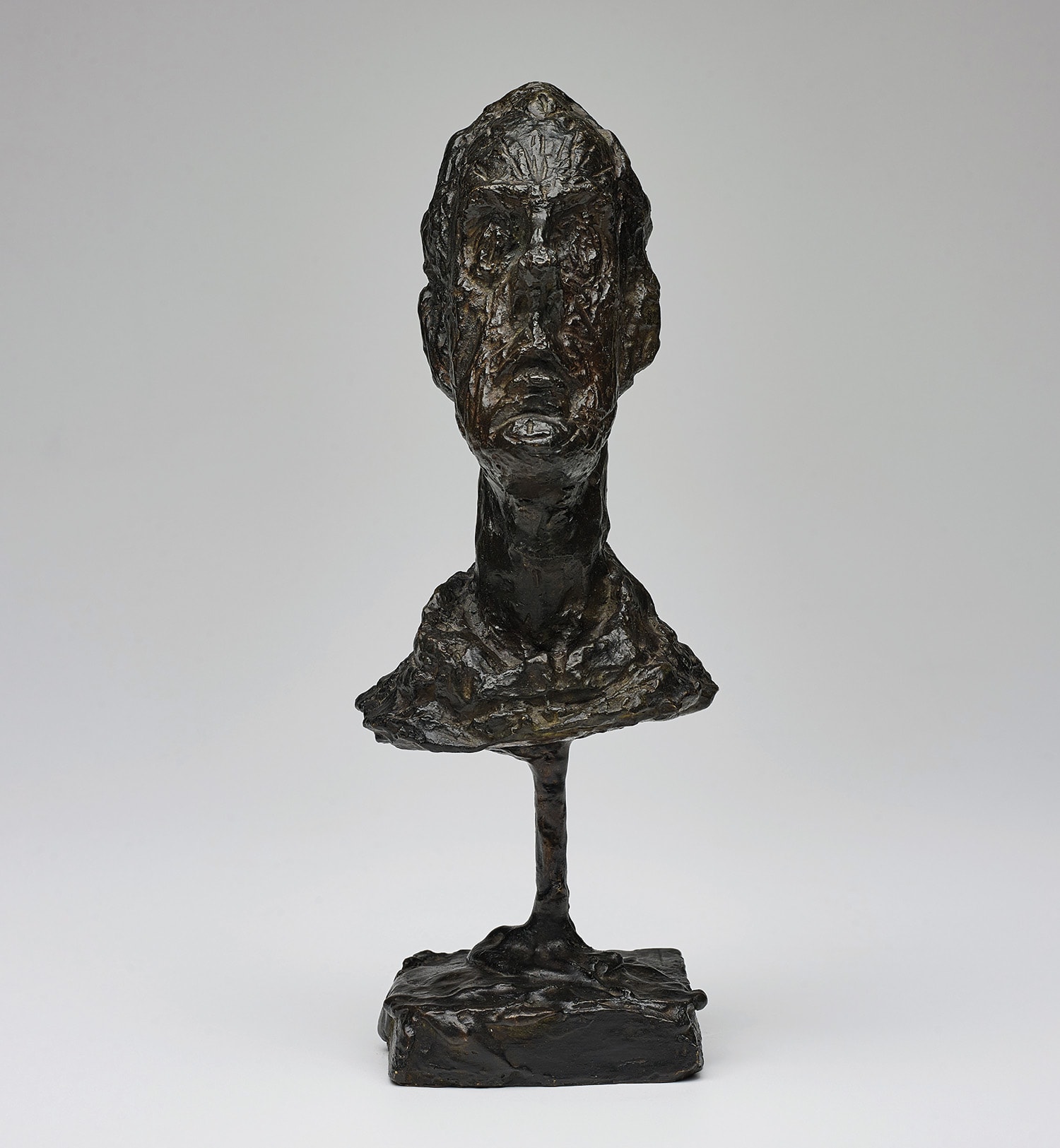







12
Alberto Giacometti
Diego [tête au col roulé]
incised with the artist's signature and number 'Alberto Giacometti 4/8' on the back of the base; further stamped with the foundry mark 'Susse Fondeur Paris' on the left side of the base; further stamped with the foundry mark and incised 'Susse Fondeur Cire Perdue' on the inside of the base
bronze with green-brown patina
33 x 12.9 x 14.4 cm (12 7/8 x 5 1/8 x 5 5/8 in.)
Conceived circa 1954, cast in bronze in 1980 by Susse Fondeur, Paris, this work is cast number 4 from an edition of 8 plus one 0 cast and a further Maeght Foundation cast. This work is recorded in the Alberto Giacometti Database under no. 1561, and is accompanied by a certificate of authenticity from the Giacometti Committee.
Full-Cataloguing
An elegant rendering of Diego, Alberto Giacometti's younger brother and most prominent model, Diego [tête au col roulé], conceived circa 1954 and later cast in 1980, belongs to a body of sculptural heads and busts that moved away from the artist's weightlessly elongated figures of the late 1940s. Drawing attention to the rolled collar of his brother’s shirt, Diego [tête au col roulé], is a sentimental variation on Giacometti’s favoured subject matter. Capturing the artist’s exceptional sculptural sensibility and the sitter's emotional gravitas, Diego [tête au col roulé] presents the viewer with a scintillating reflection of the brothers’ remarkably close relationship.
Diego Giacometti, later celebrated as an artist and designer in his own right, lived and worked with his brother Alberto in Paris, assisting his creative enterprises by creating support structures, building plaster casts, and patinating bronze. Sitting regularly for Alberto’s studies, Diego was painstakingly committed to his brother’s craft throughout his lifetime, and it wasn't until after Alberto’s death in 1966 that he could turn his full effort and energy to furniture making, with his priorities no longer split. As Alberto’s primary model, Diego fulfilled the role of muse, and each of his brother’s intricate depictions, whether in plaster, oil or charcoal, emits the strength and reality of unfaltering love. In order to achieve the sense of presence and spirit in his heads and busts, Giacometti repeatedly formed and broke down his plaster model during the creation process, musing ‘I shall never succeed in putting into a portrait all the power a head contains’ (Alberto Giacometti, quoted in Reinhold Hohl, ed., Giacometti: A Biography in Pictures, Ostfildern-Ruit, 1998, p. 148).
Drawing influence from ancient Egyptian forms, Giacometti masterfully amalgamated the formal rigour of this ancient culture with the processes of artistic making and seeing. Absorbing reality and translating it into rich, complex forms was Giacometti’s prime creative impulse, and the artist considered Egyptian art to be the closest art form to the reality of nature. Having moved on from his surrealist subject matter of the early 1930s, inspired by and, equally, inspiring the monumental work of Salvador Dalí, Max Ernst and Joan Miró, Giacometti began forming his exceptionally dynamic stick-like figures in 1935. ‘Giacometti had indeed chosen the existence of individuals, the here and now as the chief object of his new and future study…He instinctively realized that this object transcended all artistic signs and representations, since it was no less than life itself’ (Yves Bonnefoy, Alberto Giacometti: Biographie d'une oeuvre, Paris, 2012, p. 369).
By 1950, with the impression that he had exhausted the potential of his elongated forms, the artist sought to form a more tangible conception of human presence within space. With Annette, his wife, serving as his female model, and Diego as the male sitter, the artist once again committed – and cemented – his younger brother to his sculptural creations. The motion, inherent within his tall, striding figures, is here entirely removed, as his new subjects took on the form of heads or busts, never stretching farther than their torso. Stripped of active movement, instead teeming with the expressive character of his chief sitter’s face, Giacometti forged an exceptional model brimming with unique life and soul. ‘If the gaze, that is life, is the main thing,’ the artist mused ‘then the head becomes the main thing, without a doubt. The rest of the body is limited to functioning as antennae that make people’s life possible - the life that is housed in the skull’ (Alberto Giacometti, quoted in Yves Bonnefoy, Alberto Giacometti: Biographie d'une oeuvre, Paris, 2012, p. 146). Further underlining the importance of the eyes as the window to the soul, and the focal point around which his busts are formed, the artist noted: ‘In these sculptures I tried to make an eye…I raised the head on a base until the eye is at eye-level. You see an eye... This is very important... just where the eye hits the sculpture’ (Alberto Giacometti, quoted in Thomas B. Hess, 'Giacometti: The Uses of Adversity', Art News, vol. 57, no. 3, May 1958, pp. 34-35).
Celebrating a lifelong collaboration with Diego as Alberto’s studio assistant, model, muse, brother and collaborator, the exceptional bond between the two brothers instils the present work with a sense of inimitable intimacy. Extending the frame of the work through sentimental, art historical and mental structures, Diego [tête au col roulé] is an exceptionally multi-dimensional and emotional figure, testament to Giacometti’s engaging vision of the human form. Musing on the gravitas and extreme dimensionality of the artist’s creations, Jean-Paul Sartre exclaimed: ‘What I see is teeming cohesion, contained dispersal…. For him, to sculpt is to take the fat off space’ (Jean-Paul Sartre, ‘Situations’, George Braziller, The Words: Autobiography of Jean-Paul Sartre, United States, 1965, n.p.).
Diego Giacometti, later celebrated as an artist and designer in his own right, lived and worked with his brother Alberto in Paris, assisting his creative enterprises by creating support structures, building plaster casts, and patinating bronze. Sitting regularly for Alberto’s studies, Diego was painstakingly committed to his brother’s craft throughout his lifetime, and it wasn't until after Alberto’s death in 1966 that he could turn his full effort and energy to furniture making, with his priorities no longer split. As Alberto’s primary model, Diego fulfilled the role of muse, and each of his brother’s intricate depictions, whether in plaster, oil or charcoal, emits the strength and reality of unfaltering love. In order to achieve the sense of presence and spirit in his heads and busts, Giacometti repeatedly formed and broke down his plaster model during the creation process, musing ‘I shall never succeed in putting into a portrait all the power a head contains’ (Alberto Giacometti, quoted in Reinhold Hohl, ed., Giacometti: A Biography in Pictures, Ostfildern-Ruit, 1998, p. 148).
Drawing influence from ancient Egyptian forms, Giacometti masterfully amalgamated the formal rigour of this ancient culture with the processes of artistic making and seeing. Absorbing reality and translating it into rich, complex forms was Giacometti’s prime creative impulse, and the artist considered Egyptian art to be the closest art form to the reality of nature. Having moved on from his surrealist subject matter of the early 1930s, inspired by and, equally, inspiring the monumental work of Salvador Dalí, Max Ernst and Joan Miró, Giacometti began forming his exceptionally dynamic stick-like figures in 1935. ‘Giacometti had indeed chosen the existence of individuals, the here and now as the chief object of his new and future study…He instinctively realized that this object transcended all artistic signs and representations, since it was no less than life itself’ (Yves Bonnefoy, Alberto Giacometti: Biographie d'une oeuvre, Paris, 2012, p. 369).
By 1950, with the impression that he had exhausted the potential of his elongated forms, the artist sought to form a more tangible conception of human presence within space. With Annette, his wife, serving as his female model, and Diego as the male sitter, the artist once again committed – and cemented – his younger brother to his sculptural creations. The motion, inherent within his tall, striding figures, is here entirely removed, as his new subjects took on the form of heads or busts, never stretching farther than their torso. Stripped of active movement, instead teeming with the expressive character of his chief sitter’s face, Giacometti forged an exceptional model brimming with unique life and soul. ‘If the gaze, that is life, is the main thing,’ the artist mused ‘then the head becomes the main thing, without a doubt. The rest of the body is limited to functioning as antennae that make people’s life possible - the life that is housed in the skull’ (Alberto Giacometti, quoted in Yves Bonnefoy, Alberto Giacometti: Biographie d'une oeuvre, Paris, 2012, p. 146). Further underlining the importance of the eyes as the window to the soul, and the focal point around which his busts are formed, the artist noted: ‘In these sculptures I tried to make an eye…I raised the head on a base until the eye is at eye-level. You see an eye... This is very important... just where the eye hits the sculpture’ (Alberto Giacometti, quoted in Thomas B. Hess, 'Giacometti: The Uses of Adversity', Art News, vol. 57, no. 3, May 1958, pp. 34-35).
Celebrating a lifelong collaboration with Diego as Alberto’s studio assistant, model, muse, brother and collaborator, the exceptional bond between the two brothers instils the present work with a sense of inimitable intimacy. Extending the frame of the work through sentimental, art historical and mental structures, Diego [tête au col roulé] is an exceptionally multi-dimensional and emotional figure, testament to Giacometti’s engaging vision of the human form. Musing on the gravitas and extreme dimensionality of the artist’s creations, Jean-Paul Sartre exclaimed: ‘What I see is teeming cohesion, contained dispersal…. For him, to sculpt is to take the fat off space’ (Jean-Paul Sartre, ‘Situations’, George Braziller, The Words: Autobiography of Jean-Paul Sartre, United States, 1965, n.p.).